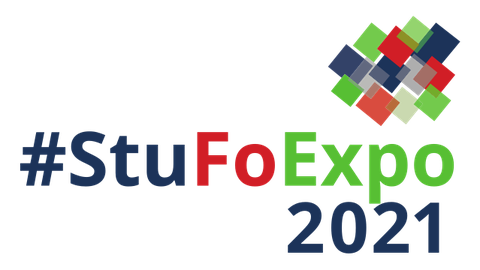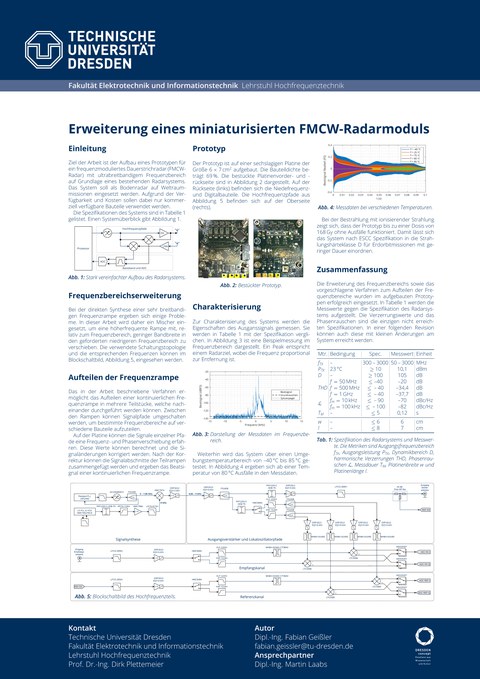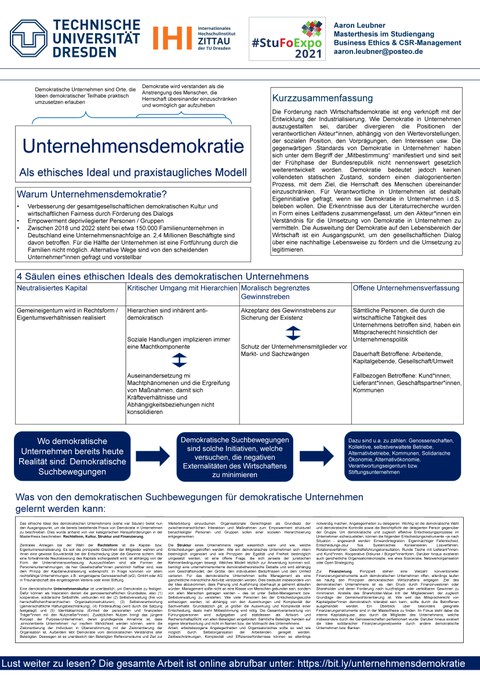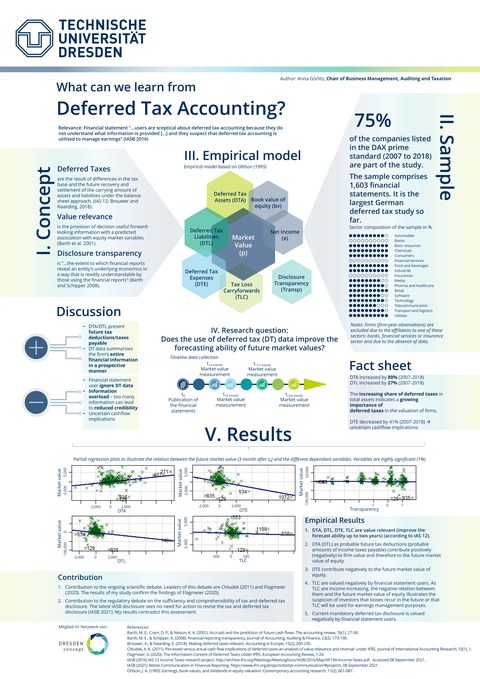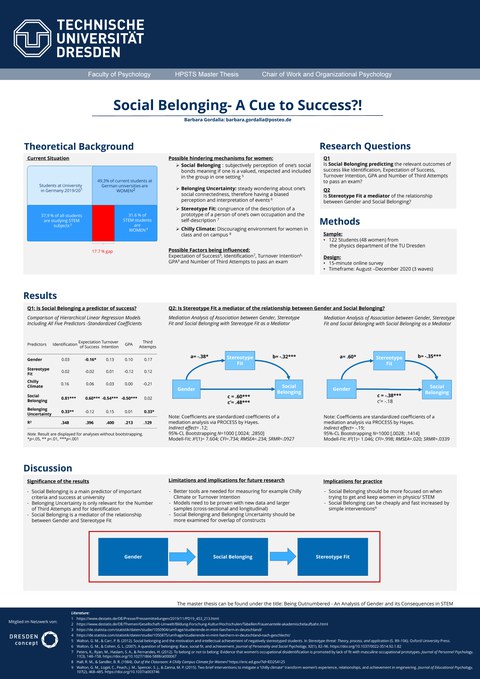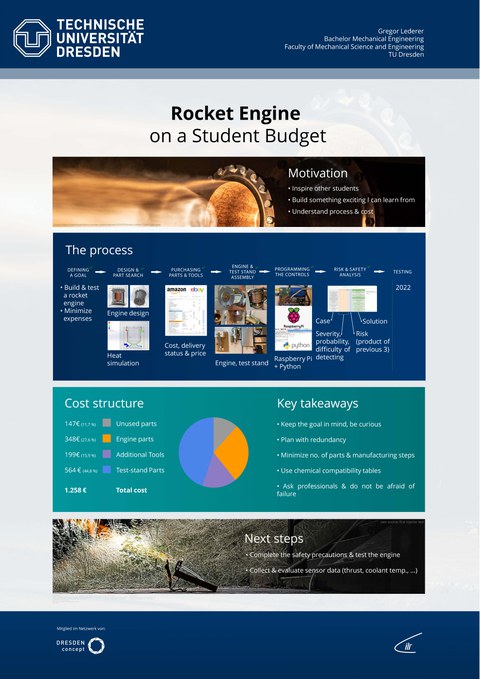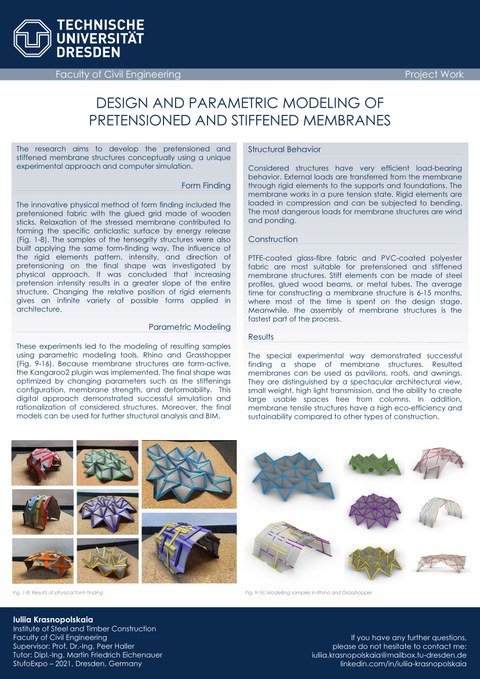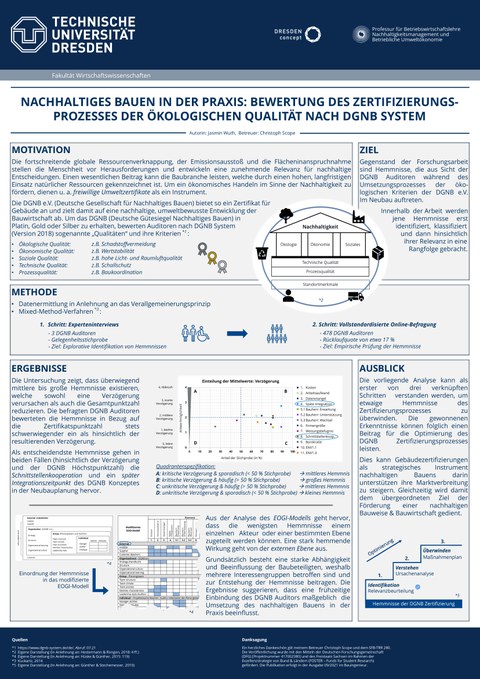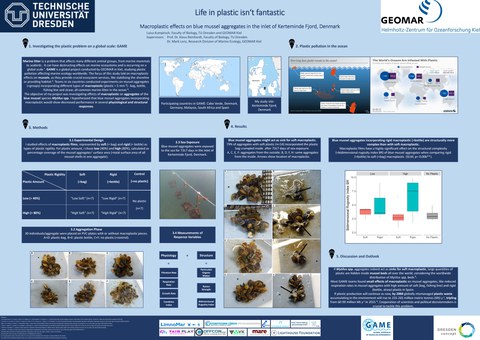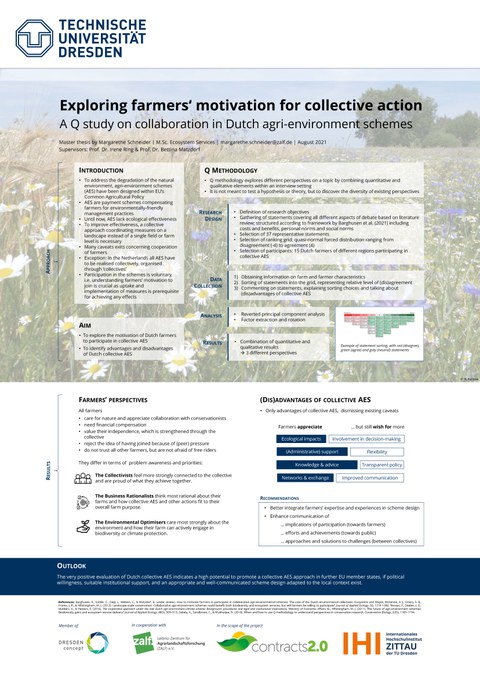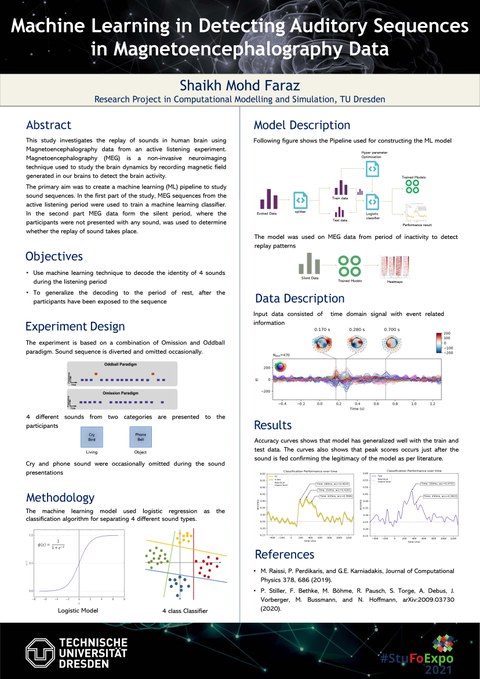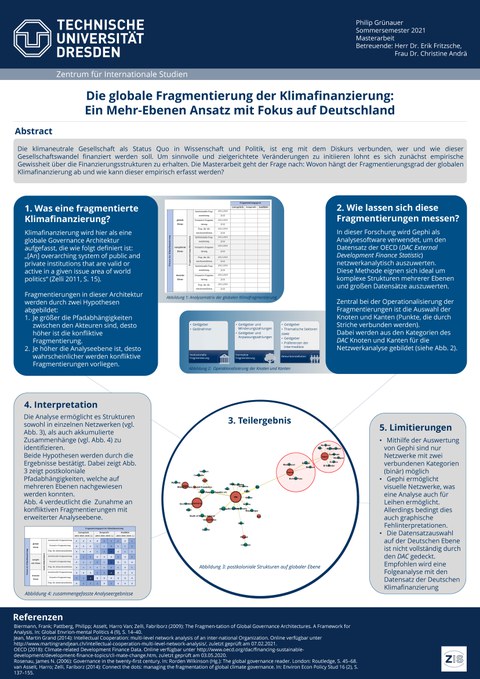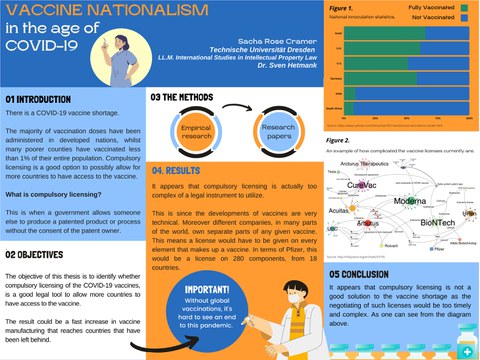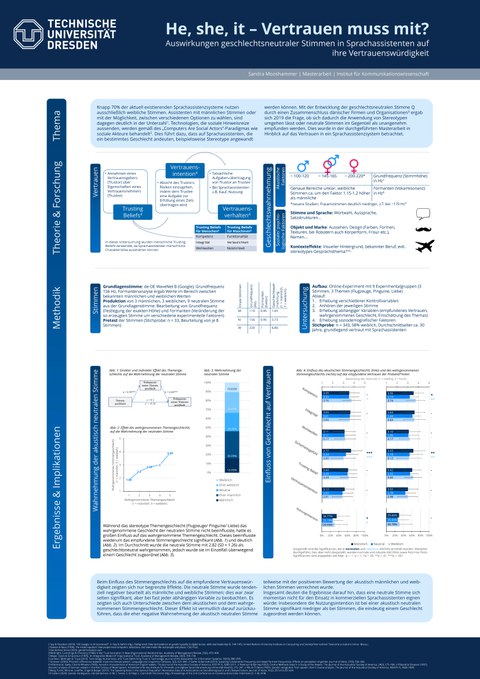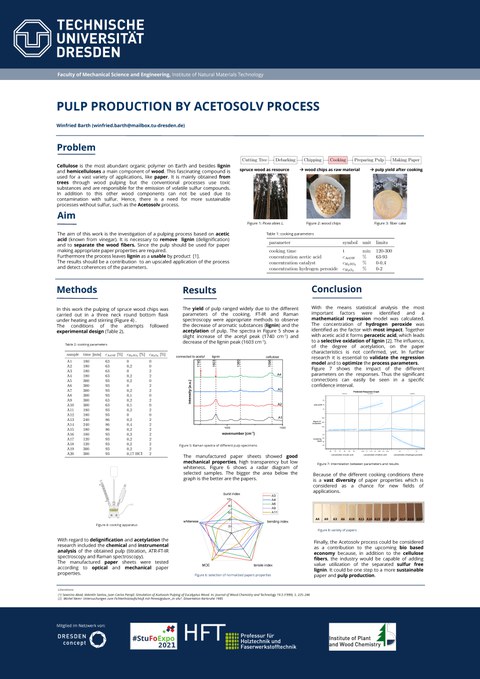StuFoEXPO 2021
This year’s StuFoExpo took place as an online conference on 16th September 2021 from 5 pm. Enthusiastically, Dr. Martin Gerner from the Centre for Interdisciplinary Learning and Teaching led the event.
A dialogical greeting with Vice-Rector for Research Prof. Angela Rösen-Wolff formed the prelude giving us insights into her work and her personality. After this interview we can safely say: It is not just her job, but much more her calling, which she pursues with passion and great commitment.
That personal insight was followed by a keynote speech by Nadine Kulbe from the field of Folklore on the subject of Provenance Research, which deeply touched the audience and everyone involved. She showed us how important it is to search for items stolen by the Nazis and return them to their rightful owners or their descendants, as well as how much this contributes to our coming to terms with history and how much of this we still need to shed light upon.
Then Dr. Cathleen M. Stützner from the Centre for Quality Analysis left the audience speechless by presenting her complex work on the tech4comp project. After this presentation, it was clear to everyone that the social sciences are an in-depth and serious field of research. In the digital field, this kind of socio-technical research that blurs the borders between humanities, social science, computer science and mathematics is becoming increasingly important.
Subsequently, the fifteen pitches began demonstrating a different kind of cinematic feat: These 90-seconds short videos of student research projects were bursting with creativity and skill, each completely original and humorous. But to cut a long story short – we very much recommend that you see the pitches, posters and content of the projects for yourself.
Abstract
This thesis presents the design of a miniature frequency modulated continuous wave (FMCW) radar with a frequency range of 50 MHz to 3 GHz using only commercial off the shelf (COTS) components. The system is intended for use as ground penetrating radar (GPR) as part of a lunar lander. State of the art topologies for ultra wideband signal synthesis are presented and compared. The theoretical background of split frequency ramps and the thus required stitching of baseband signals is discussed. The schematic design, layout and software development is described.
The characterization of the radar system shows that the specification is met within a temperature range of −40 °C to 75 °C and while exposition to radiation with an accumulated dose of up to 168 Gy. The use of COTS components does not impair the performance. Finally suggestions for hard- and software improvements are given, that resulted from working with the radar system.
Pitch
© Fabian Geißler
Poster
Abstract
Following the first record of Myrmeleon bore (Tjeder, 1941) in the Dresden Heath area in 2019 (KURTH 2020, Sächs. Entomol. Z. 10: 71-80), the population size and density of the species was determined. M. bore mainly was found in open, sparsely vegetated, sandy areas with direct sunlight exposure. The area-weighted density of the entire study site (4.05 hectares) was 0.177 larvae/m2. Population size estimates based on random quadrat counts lead to a figure of 4000-7000 individuals - the largest known population of this species. The positive correlation between larval size and pit diameter known for this species from laboratory trials was confirmed at our study site. This correlation may allow researchers to estimate the age structure of wild populations. Given the special responsibility of Germany for the protection of this species and the size of the population, we urge the protection of the site and a prioritisation over other protected species found in the area.
We like to thank Prof. Dr. Reinhardt for his great support.
Pitch
Population size, pit density and habitat preference of the ant lion Myrmeleon (Tjeder, 1941) in the Dresdner Heide, Saxony (Neuroptera). © Aaron Anselmi
Poster
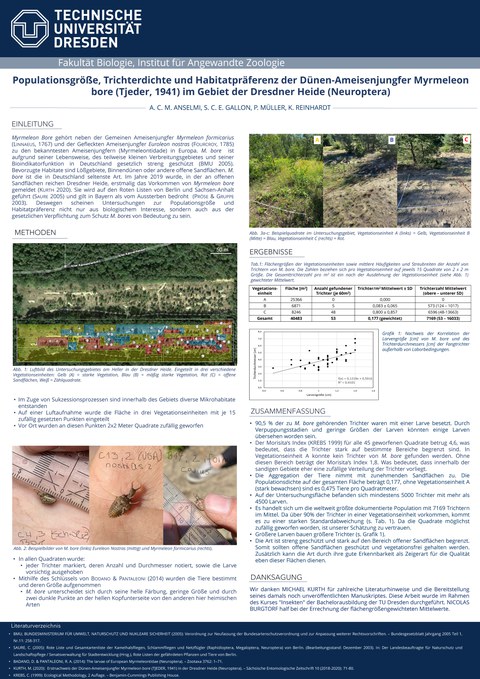
Research work on Myrmeleon bore in the area of the Dresdner Heide
Abstract
The demand for economic democracy is closely linked to the historical process of industrialization. How democracy should be designed in companies, the positions of the responsible actors diverge, depending on the values, the social position, the preconceptions, the interests, etc. The current 'standards of democracy in companies' have come under the term of "And have not been further developed legally since the early phase of the Federal Republic of Germany. However, democracy does not mean a perfect static state, but a dialogue-oriented process with the aim of restricting the rule of people over one another. For those responsible in companies, initiative is therefore required if they want to stimulate democracy in companies in the sense of the word. The findings from the literature research were summarized in the form of a guide in order to give the actors an understanding of the implementation of democracy in companies. The expansion of democracy to include the economy is a starting point for promoting social dialogue about a sustainable way of life and legitimizing its implementation.
Pitch
Between 2018 and 2022, around 150,000 family businesses in Germany are due for succession. 2.4 million employees are affected. For half of the companies, continuation by the families is not possible. Alternative paths are in demand and conceivable for the © Aaron Leubner
Poster
Abstract
The StuFo-Expo gives me the opportunity to make my research accessible to a broad, interdisciplinary public as part of my doctoral project. I also get the chance to get to know research topics, results and methods across disciplines. It is a unique project that connects students with one another and promotes important student skills.
The topic of my research is the value relevance of deferred taxes. I am investigating the question of whether deferred taxes provide additional information for various stakeholders when predicting future corporate development. To do this, I analyze the almost 1,800 available annual financial statements of all companies listed in the DAX Prime Standard between 2007 and 2018.
The poster I submitted shows that deferred taxes help forecast the development of the market value of equity up to two years in advance. Deferred tax assets as probable future tax repayments contribute positively to the company value and therefore to the market value, and deferred tax liabilities as probable future tax payments contribute negatively to the company value and therefore to the market value. I can also prove that the supplementary reporting on deferred taxes is rated negatively by market participants. Possible reasons for this are the high complexity of the information and the lack of transferability of this information to balance sheet and income statement figures. Interview studies also show that trust in deferred taxes and the associated reporting is low, as stakeholders suspect that deferred taxes are at least partially used for accounting policy.
Pitch
© Anna Görlitz
Poster
Abstract
Currently, the percentage of female students in STEM majors is about 17% lower than in other majors. What factors lead to this situation?
A variety of factors impact student choice and persistence. The underlying master's thesis examined the relationships between gender, social belonging, belonging uncertainty, stereotype fit, and chilly climate. In particular, the focus was on exploring the influence of social belonging on selected success parameters (identification, expectation of success, turnover intention, grade point average, and number of third attempts to pass an exam performance). It also examined whether Stereotype Fit acts as a mediator on the relationship between gender and Social Belonging.
The study was based on an online survey at the Faculty of Physics at the TU Dresden. The results show that women reported lower scores in Social Belonging and Stereotype Fit, and higher scores in Belonging Uncertainty.
Identification was predicted by both Social Belonging and Belonging Uncertainty. Expectation of success was significantly affected by gender and Social Belonging. For grade point average and turnover intention, Social Belonging was the only significant predictor. The number of third attempts was positively predicted by Belonging Uncertainty. The hypothesis that Stereotype Fit is a mediator could not be supported by the data. Instead, exploratory mediation analyses show that Social Belonging and Belonging Uncertainty are more likely to be mediators of the relationship between gender and Stereotype Fit.
All results suggest that Social Belonging is an important factor for women's success in STEM fields. Therefore, it can be inferred that promoting Social Belonging in college would have a positive impact on women's success.
Current research shows that Social Belonging can be increased through low-cost and brief interventions. Implementation of promotional opportunities in the educational context is recommended as part of further research.
My sincere thanks go to Dr. Anika Ihmels for the empowering supervision during the master thesis as well as the Faculty of Physics, its Equal Opportunity Officer and the FSR Physics, who made the survey possible and supported it.
Pitch
© Barbara Gordalla
Poster
Abstract
A technical project alongside the University courses can deepen the understanding and increase the motivation for the subject of choice. As a student, there is often a hurdle to start such a project because of a lack of inspiration. And even after overcoming this, the costs associated with such a project may put students off.
With my project I show how a 3rd semester Mechanical Engineering student can design and manufacture a rocket engine with all testing components on a student budget. Cost structure and resource planning are explained in detail.
I launched the project in December 2020 and in September 2021 it was presented at the StuFoExpo21. A general curiosity for the topic and a basic understanding of mechanical engineering was sufficient for starting the project. Importantly, I gained the most valuable knowledge during the implementation of the project, through active failure-iteration and reading specialised literature.
The project is focussed on the design and manufacturing of a rocket engine and its testing components. A special feature is the cooling jacket of the combustion chamber. It has been 3D printed in the SLUB Makerspace, a facility at TU Dresden. Further work packages of the project were the programming of sensors and control systems, first open-air combustion tests of the injector head, safety checks and a Risk & Safety analysis. The first testing and other preliminary work were performed in collaboration with fellow students. During the entire design and manufacturing process I was in continuous exchange with the research group “Space Transportation” of the Institute of Aerospace Engineering at TU Dresden. Special thanks go to Dipl.-Ing. Jan Sieder-Katzmann and Dipl.-Ing. Maximilian Buchholz for their help during this process.
For 2022 I plan a test campaign of the rocket engine to collect sensor data and to perform engine thrust measurements.
Pitch
© Gregor Lederer
Poster
Abstract
This research aimed to develop conceptually the pretensioned and stiffened membrane structures, using an experimental approach and computer simulation.
The physical method of form finding included the pretensioned fabric with the glued grid made of the wooden sticks. Relaxation of the stressed membrane contributed to forming the specific anticlastic hyparic surface by energy release. The influence of the rigid elements pattern, intensity and direction of pretensioning on the final shape was investigated. The tensegrity structures were also built applying the same form finding way.
These experiments led to the modelling of resulting samples with parametric design tools, namely Rhino and Grasshopper. Optimization of the final shape was carried out by changing parameters such as stiffenings configuration and membrane strength. This digital approach demonstrated successful simulation and rationalization of considered structures. Moreover, the final models can be used for further structural analysis and BIM.
Considered membrane structures have very efficient load-bearing behavior. They are characterized by small weight, high light transmission and the ability to create large usable spaces free from columns. The most dangerous loads for membrane structures are wind and ponding.
In practice, PTFE coated glass-fibre fabric and PVC coated polyester fabric are most suitable for pretensioned and stiffened membrane structures. The role of stiff elements can be played by steel profiles or metal tubes. The average time for the construction of a membrane structure is 6-15 months.
Resulted pretensioned and stiffened membrane structures can be used as pavilions, roofs and awnings. They are distinguished by spectacular architectural view and very effective structural system. In addition, membrane tensile structures are characterized by high eco-efficiency and sustainability compared to other types of construction.
Pitch
© Iuliia Lebedeva (ehem. Krasnopolskaia)
Poster
Abstract
Linking theory and practice, university research and the real economy, is a pillar of social development. With the financial support of the FOSTER program of the TU Dresden, I succeeded in this desired connection, even before the first dust on my thesis has settled down. With the support of the professorship for business administration, especially sustainability management and corporate environmental economics, I was able to transfer my diploma thesis from theory to practice, from the university to a renowned specialist journal. In my thesis, I dealt with the obstacles in the certification process of the German Sustainable Building Council (DGNB e.V.). The DGNB system in new buildings aims to ensure a holistic assessment of a building in terms of sustainable construction. I have examined which obstacles, from the point of view of the DGNB auditors, can arise in the course of the certification process when assessing ecological quality. Expert interviews with three auditors formed the basis for a structured questionnaire that was sent to all registered DGNB auditors. While the interviews served the explorative identification and systematisation of disruptive factors, the questionnaire empirically examined the extent to which these affect the course of certification over time and the achievement of the highest possible score. The interface cooperation and a late integration date of the DGNB concept in the planning of new buildings emerge as the most decisive obstacles. The analysis lays the foundation for overcoming any obstacles and can consequently make a contribution to optimizing the certification process. This can support building certification as a strategic instrument for sustainable building in establishing itself in the construction industry and increasing its market penetration. At the same time, this serves the overriding goal of promoting sustainable building methods and the construction industry. Further results will be published in an article in the specialist journal "Bauingenieur" in 2021. So, in close coordination with the professorship and the FOSTER funding, I managed to keep my research in a drawer and to publish my results instead.
Pitch
© Jasmin Wuth
Poster
Abstract
Marine litter is a problem that effects a lot of different marine species, from mammals to invertebrates. It can have several destructing effects on marine ecosystems and is occurring on a global scale. The aim of my research in Kerteminde, Denmark, was to understand potential physiological and structural effects of marine plastic debris (= macroplastic) on aggregates of the blue mussel species Mytilus spp. It is common among these animals to build aggregates in intertidal and shallow subtidal habitats. They provide several ecosystem services, like stabilizing the shoreline or providing habitat for other species. Blue mussels are filter-feeders and so contributing to bioremediation, which is a key capacity to remove wastes from marine ecosystems. Considering the ecosystem services mussel aggregates provide, it is crucial to understand any factors that could harm this structure. My focus laid on the effects of rigid and soft macroplastic films, i.e. bottles and bags, as they represent common marine litter worldwide. I found that macroplastic indeed affects the structure of blue mussel aggregates. My project was part of a global study, organized by GEOMAR Kiel, where Master students from six countries conducted the same experiments to compare macroplastic effects on a global scale. I would like to thank the GAME program at GEOMAR Kiel for financing my research as wells as Dr. Mark Lenz for the organization of the project. Moreover, I want to thank the Marine Biological Research Center in Kerteminde for hosting me during my research.
Pitch
© Luisa Kumpitsch
Poster
Abstract
Within the European Union’s Common Agricultural Policy, agri-environment schemes (AES) have been designed to address the degradation of the natural environment caused by agriculture. To improve the schemes’ ecological effectiveness, a collective approach focusing on a landscape instead of a single farm level is recommended. This approach is rarely applied across Europe except for the Netherlands, where all AES have to be realised collectively since 2016. As participation in the schemes is voluntary, understanding farmers’ motivation to join is crucial since the uptake and implementation of measures is prerequisite for achieving any effects. Hence, the aim of this study is to explore Dutch farmers’ motivation to participate in collective AES and to find out about the scheme’s main advantages and disadvantages perceived by the farmers. A Q study with 15 farmers from six provinces shows three dominant motivational views: a collective-oriented, a business-oriented and an environment-oriented perspective. All farmers unites their affection and care for nature, which is accompanied by different levels of problem awareness and affiliation to the collective. Financial compensation is deemed important by all, yet rather as necessary mean to enable required changes in farming practices than as additional source of revenue. While the Dutch schemes can still be further improved to allow for more flexibility, a better integration of the farmers’ knowledge and enhanced communication, all farmers dismiss many caveats related to collective action, indicating a potential to promote the Dutch approach beyond national borders.
Pitch
© Margarethe Schneider
Poster
Abstract
Does your brain replay your recent life experiences while you are resting? An open question in neuroscience is which events does our brain replay and is there any correlation between the replay and duration of the event?
In this study I tried to investigate this question by using Magnetoencephalography data from an active listening experiment. Magnetoencephalography (MEG) is a non-invasive neuroimaging technique used to study the brain activity and understand brain dynamics in perception and cognitive tasks particularly in the fields of speech and hearing. It records the magnetic field generated in our brains to detect the brain activity.
I build a machine learning pipeline which uses part of the experiment data to learn the sound patterns and then predicts the presence of sound in the later part of the recordings in which the participants were made to sit idle and no sound was fed. The aim of the study of test replay of learned sound sequences in the post listening period. I have used classification scheme to identify patterns if MEG responses to different sound sequences in the post task period.
The study concluded that the sound sequences can be identified and distinguished above theoretical chance level and hence proved the validity of our classifier. Further, the classifier could predict the sound sequences in the post-listening period with very high probability but in order to validate the model results on post listening period, more evidence is needed.
Pitch
© Shaikh Mohd Faraz
Poster
Abstract
Climate neutrality is being put on the political agenda of an increasing number of countries around the world, including Germany and Europe. The goal of achieving greenhouse gas neutrality in Europe by 2050 is a politically agreed consensus through the European Green New Deal.
But how should an ecological, economic and social transformation of this magnitude be financed? As diverse and plural as the effects of climate change are, the political and financial cooperation for mitigating and adapting to climate change is decentralized and fragmented.
The master's thesis therefore examines the question: What does the degree of fragmentation of global climate finance depend on and how can this be empirically recorded?
Starting from a theoretical perspective of fragmented climate finance, German, European and global actors are evaluated with the help of a visual network analysis and structural patterns are interpreted with regard to the degree of fragmentation. Post-colonial structures, changes in norms and sectoral shifts can thus be worked out, as can changes in the constellations of actors and their types. As a result, the German level can be interpreted as largely synergetically fragmented. The European level, on the other hand, is mostly cooperatively fragmented, while the global level is viewed as cooperatively to conflictively fragmented.
The innovative approach of evaluating cooperation in climate finance using OECD data in a network analysis is associated with both opportunities and risks. In addition to the content-related results, the method reflection therefore contributes to a scientific discourse on the meaningfulness, usability and didactics of the method in international relations.
Pitch
© Philip Grünauer
Poster
Abstract
It is no secret that the world has a COVID-19 vaccine problem. The majority of vaccination doses have been administered in Europe and North America, whilst many poorer counties have vaccinated less than 1% of their entire population.
In light of the new variants presenting health risks, countries such as South Africa and India have proposed that the World Trade Organisation temporarily waive intellectual property rights for COVID-19 vaccines to help increase the production of vaccines. The world’s economic powerhouses such as U.S., Britain and the European Union vetoed the idea, submitting that intellectual property rights are important for ensuring continued innovation. They are of the opinion that waiving such rights would not result in increased production.
The question therefore stands if these are only two options: either patents remain unchanged, or patents are disregarded. An alternative, and perhaps a middle ground is that of compulsory licensing. Although a seemingly good option, it presents its own problems. For instance, patents are territorial and grant the patent holder a monopoly for a limited time of 20 years. However, based on public needs – including health emergencies, a government can allow others to make the product, usually with a fair royalty, or fee, paid to the patent owner. However, this ends at the border. Article 31 of the WTO’s Agreement on Trade-Related Aspects of Intellectual Property Law, or TRIPS, limit compulsory licenses primarily to domestic production and use. This is also limited to companies within the territory, producing products primarily for export. This of course would make the whole point of such compulsory licenses redundant, since the countries producing such vaccines are not the countries that do not have access to them.
The other problem with the COVID-19 vaccine is that the technologies used in producing such vaccines are complex and involve numerous patents, trade secrets and know-how. A compulsory licensing system would need to address not just patents but also the related intellectual property in question.
To successfully expand vaccine production, countries need a moderately smooth structure to allow a country such as India, to grant a single, blanket license allowing companies to produce vaccines develop by the U.S. or European companies for export to all countries that lack their own manufacturing capacity.
The proposed WTO waiver of intellectual property rights seeks to address the need of improved vaccine production, but it may be little too far stressed. Compulsory licensing would smooth the way for the expansion of vaccine manufacturing whilst at the same time still compensating the right holders.
Pitch
© Sacha Rose Cramer
Poster
Abstract
Almost 70 % of the currently existing language assistance systems only use female voices. Assistants with male voices or with the option to choose between different options, on the other hand, are clearly in the minority. Technologies that emit social cues are treated like social actors in accordance with the CASA paradigm. As a result, stereotypes, for example, can be applied to voice assistants who indicate a specific gender - an effect that has already been observed in various research.
With the development of the gender-neutral voice Q through a merger of Danish companies and organizations, the question arose in 2019 whether this would avoid the use of stereotypes or, on the contrary, neutral voices are perceived as unpleasant. This was considered in the master's thesis with regard to trust in a language assistance system. For this purpose, a gender-neutral voice was developed and compared in an online experiment with a male and a female voice that spoke about a stereotypically male, a stereotypically female or a neutral topic. It was found that the neutral voice was assigned a lower level of trustworthiness in some variables - even if it was perceived as male or female. The gender assignment, in turn, was dependent on which gender the test subjects assigned the topic about which the voice was speaking.
The results suggest that the ambiguity and unfamiliarity of the neutral voice leads to a poorer rating. It must therefore be doubted that such projects can lead to a broad-based overcoming of stereotypes, but on the contrary even bring about and consolidate negative reactions to entities that do not correspond to the gender norm.
Pitch
© Sandra Mooshammer
Poster
Abstract
Cellulose is the most abundant organic polymer on Earth and a fascinating compound for a vast variety of applications. It is mostly received from wood, thus it is a renewable resource and a CO2 storing material. One of the most important cellulose products are pulp and paper.
The major goal of this work was to obtain a material with a high amount of cellulose through a pulping process of wood. Therefore, it is necessary to separate the wood bers and to remove a component of wood, which is called lignin (deligni cation). The conventional way to delignify wood is the Kraft process that causes serval problems like contamination of lignin with sulfur and the emission of toxic volatile sulfur compounds. Hence, there are alternative processes without sulfur, such as the Acetosolv process. It uses simple chemicals like acetic acid and is easy to handle.
After cutting a spruce tree (Picea abies L. Karst.), debarking and chipping, the wood chips were cooked in the laboratory. The research included the chemical analysis of the obtained pulp and the manufacturing and testing of paper sheets.
The yield of pulp ranged widely due to the di erent parameters of the cooking. FT-IR and Raman spectroscopy were used to observe the decrease of aromatic substances (lignin) and the acetylation of the pulp.
With the means of Design of Experiments and statistical analysis the most important factors were identi ed and a mathematical regression model was calculated. The manufactured paper sheets showed good mechanical properties and high transparency. Finally, the Acetosolv process could be considered as a contribution to the upcoming bio-based economy because, in addition to the cellulose bers, the industry would be capable of adding value utilization of the separated lignin. It could be one step to a more sustainable paper and pulp production.
Pitch
© Winfried Barth
Poster
After the pitches had been presented, the jury award was handed over. The jury had received the posters and pitches in advance in order to evaluate them extensively and thoroughly by means of a questionnaire. And one thing became very clear: All contributions were of high quality and received high scores. After our assessment of the evaluation sheets, the best projects were chosen on the basis of the jury evaluations. The prize money of 300 euros each was won by:
1st place: Winfried Barth from the field of Process Engineering and Natural Materials Technology for the best student research work on the topic Pulp production by acetosolv process
2nd place: Sandra Mooshammer from the field of Applied Media Research with the topic He, she, it – Vertrauen muss mit? Auswirkung geschlechtsneutraler Stimmen in Sprachassistenten auf ihre Vertrauenswürdigkeit
3rd place: Jasmin Wuth from Economics with the topic Sustainable building in practice: Evaluation of the certification process for ecological quality according to the DGNB system
We would like to thank the jury members very much, who made a decisive contribution with their expertise and commitment. Our thanks go to:
- the former StuFoExpo winner Lukas Körber, current PHD student at HZDR.
- Anne Jantos, research assistant at the Chair for Information Systems, especially Information Management.
- Prof. Sven Herzog, professor for Game Ecology and Hunting Management.
- Dr. Maren Goeckenjan, senior physician at the Clinic and Polyclinic for Gynecology and Obstetrics.
- Pauline Dunkel, research assistant at the Center for Interdisciplinary Learning and Teaching and at the Center for Quality Analysis.
- Hauke Lerche and Christoph Steiert, research assistants at the Chair of Fluid Mechatronic System Technology.
To claim one of the 300 euro prizes, the participants presented their posters in breakout rooms. And despite technical difficulties, it has to be said: You did a great job. In a live vote, the audience decided on their personal winners of the evening:
1st place: Gregor Lederer from the field of Mechanical Engineering with his project How to build a rocket engine on a student budget?
2nd place is shared by an equal placement:
- Luisa Kumpitsch from Biology with the project Life in plastic isn‘t fantastic – Macroplastic effects on blue mussel aggregates in the inlet of Kerteminde Fjord, Denmark.
- Anna Görlitz from Economics with her project What can we learn from Deferred Tax Accounting?.
During the event we asked the audience: What inspires you to research?
And the answers underline the motivation that the students and employees of our university bring with them: We have a thirst for knowledge, are full of curiosity, our environment and nature are important to us, we want to make a difference and inspire people with our work while being inspired by others, we want to recognize connections, we want to grow. And this “wanting” dear readers, this inner drive, sustains it and develops it. Our participants and committed contributors to the event set a good example.
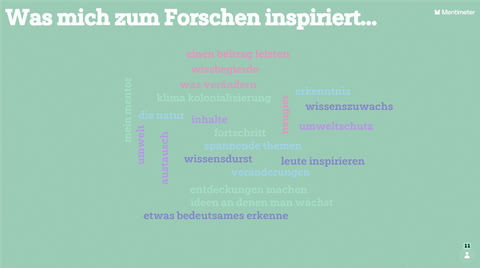
the participants’ answers to the question: What inspires me to research?
I would like to thank everyone who supported this event, as well as all those who are interested in and committed to student research. And I would especially like to thank our participants who shared their projects with us and have thus made a decisive contribution to the visibility of student research.
See you in person at StuFoExpo 2022!
Anne Jaschan
StuFoExpo 2021

